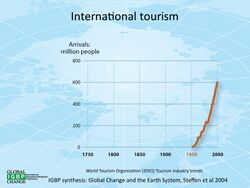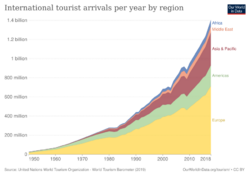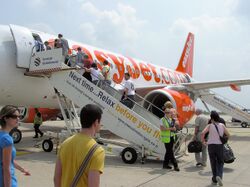International tourism
Topic: Finance
 From HandWiki - Reading time: 8 min
From HandWiki - Reading time: 8 min
International tourism is tourism that crosses national borders. Globalisation has made tourism a popular global leisure activity. The World Tourism Organization defines tourists as people "traveling to and staying in places outside their usual environment for not more than one consecutive year for leisure, business and other purposes".[1] The World Health Organization (WHO) estimates that up to 500,000 people are in flight at any one time.[2]
In 2010, international tourism reached US$919B, growing 6.5% over 2009, corresponding to an increase in real terms of 4.7%.[3] In 2010, there were over 940 million international tourist arrivals worldwide.[4] By 2016 that number had risen to 1,235 million, producing 1,220 billion USD in destination spending.[5] The COVID-19 crisis had significant negative effects on international tourism significantly slowing the overall increasing trend.
International tourism has significant impacts on the environment, exacerbated in part by the problems created by air travel but also by other issues, including wealthy tourists bringing lifestyles that stress local infrastructure, water and trash systems among others.
History
As a result of the late-2000s recession, international travel demand suffered a strong slowdown from the second half of 2008 through the end of 2009.[6] This negative trend intensified during 2009, exacerbated in some countries due to the outbreak of the H1N1 influenza virus, resulting in a worldwide decline of 4.2% in 2009 to 880 million international tourists arrivals, and a 5.7% decline in international tourism receipts.[7]
COVID-19
Some people have taken advantage of airlines drastically reducing their fares to travel for leisure despite multiple warnings to remain at home, along with two-week self-quarantine requirements upon arrival or return from travel.[8] A number of college students tested positive for COVID-19 after returning from traditional spring break destinations such as the Florida beaches, South Padre Island, and Cabo San Lucas.[9] Many tourism venues such as museums, visitor centers, restaurants and hotels mandated COVID-19 vaccination for their staff and/or visitors.[10] Research has shown that tourists have varying levels of belief on COVID-19 vaccination in terms of its effectiveness and side effects, which have impact on the preferences of tourists to preference to visit or use "vaccinated venues".[10]
Together with a decreased willingness to travel, the restrictions have had a negative economic impact on the travel sector in those regions. A possible long-term impact has been a decline of business travel and international conferencing, and the rise of their virtual, online equivalents.[11] Concerns have been raised over the effectiveness of travel restrictions to contain the spread of COVID-19.[12][13]
In Cambodia, Foreign arrivals in March 2020 fell by 65% year-on-year.[14] Angkor Wat, usually crowded with thousands of tourists per day, was left almost deserted, with an average of 22 ticket sales per day for the whole Angkor National Park during April 2020.[15][16][17] In Vietnam, Foreign arrivals in April 2020 fell by 98% year-on-year.[18]
Tourism in Hawaii went on hiatus. Tourist arrivals in Hawaii down nearly 100% in April 2020[19] and its 14-day mandatory quarantine kept tourism low.[19] A number of tourists who came to the state but did not follow the quarantine were arrested.[20] In June 2020, Hawaii had still not set a date for reopening to out-of-state tourism.[21] As of 16 June, the quarantine would be lifted for inter-island tourism.[22]Florida tourism had a year-over-year 11% drop in the first quarter of 2020.[23] During the pandemic in Door County, Wisconsin, hundreds of seasonal residents relocated to the county earlier in the spring than they typically do.[24] In 2020, staycations became popular in the United States, where most people spent their vacation time at or close to home. Most vacation travel was done by car, as gas prices are low and many people prefer to wait to the last minute to plan trips due to uncertainties. There were sharp declines in travel by air, cruise ship, bus and rail.[25]
In Australia, Tourism bodies have suggested that the total economic cost to the sector, as of 11 February 2020, would be A$4.5 billion. Casino earnings are expected to fall.[26] At least two localities in Australia, Cairns and the Gold Coast, have reported already lost earnings of more than $600 million.[27] The Australian Tourism Industry Council (ATIC) called on the Government of Australia for financial support especially in light of the large number of small businesses affected.[28] In March, national travel agency Flight Centre has indefinitely closed 100 stores throughout Australia, due to significantly lower demand for travel.[29] It also suffered a 75% decline in share price,[30] and announced that 6,000 staff would be made redundant or placed on unpaid leave globally.[31]
Rankings
Total volume of cross-border tourist travel
International tourist arrivals reached 1.035 billion in 2012, up from over 996 million in 2011, and 952 million in 2010.[32] In 2011 and 2012, international travel demand continued to recover from the losses resulting from the late-2000s recession, where tourism suffered a strong slowdown from the second half of 2008 through the end of 2009. After a 5% increase in the first half of 2008, growth in international tourist arrivals moved into negative territory in the second half of 2008, and ended up only 2% for the year, compared to a 7% increase in 2007.[33] The negative trend intensified during 2009, exacerbated in some countries due to the outbreak of the H1N1 influenza virus, resulting in a worldwide decline of 4.2% in 2009 to 880 million international tourists arrivals, and a 5.7% decline in international tourism receipts.[34]
World's top tourism destinations
In 2019, there were 1.460 billion international tourist arrivals worldwide, with a growth of 3.7% as compared to 2018.[35] The World Tourism Organization reports the following ten destinations as the most visited in terms of the number of international travelers in 2019.
| Rank | Destination | International tourist arrivals (2019)[35] |
International tourist arrivals (2018)[35] |
Change (2018 to 2019) (%) |
Change (2017 to 2018) (%) |
|---|---|---|---|---|---|
| 1 | 89 million[lower-roman 1] | 89.4 million | |||
| 2 | 83.5 million | 82.8 million | |||
| 3 | 79.3 million | 79.7 million | |||
| 4 | 65.7 million | 62.9 million | |||
| 5 | 64.5 million | 61.6 million | |||
| 6 | 51.2 million | 45.8 million | |||
| 7 | 45.0 million | 41.3 million | |||
| 8 | 39.8 million | 38.2 million | |||
| 9 | 39.6 million | 38.9 million | |||
| 10 | 39.4 million | 38.7 million | |||
Notes
| |||||
International tourism receipts
The World Tourism Organization reports that international tourism receipts were US$1.7 trillion in 2018, an increase in real terms of 4% over 2017.[36] The top ten tourism earners in 2018 were:
| Rank | Country/Area | International
tourism receipts (2018)[36] |
|---|---|---|
| 1 | $214.00 billion | |
| 2 | $74.00 billion | |
| 3 | $67.00 billion | |
| 4 | $63.00 billion | |
| 5 | $52.00 billion | |
| 6 | $49.00 billion | |
| 7 | $45.00 billion | |
| 8 | $43.00 billion | |
| 9 | $41.00 billion | |
| 10 | $40.00 billion |
International tourism expenditure
The World Tourism Organization reports the following countries as the ten biggest spenders on international tourism for the year 2018.[36]
| Rank | Country | International
tourism expenditure (2018)[36] |
|---|---|---|
| 1 | $277 billion | |
| 2 | $144 billion | |
| 3 | $94 billion | |
| 4 | $76 billion | |
| 5 | $48 billion | |
| 6 | $37 billion | |
| 7 | $35 billion | |
| 8 | $33 billion | |
| 9 | $32 billion | |
| 10 | $30 billion |
Euromonitor International Top City Destinations Ranking
Euromonitor International rated these the world's most visited cities by international tourists in 2017:[37]
| Rank | City | Country | International
tourist arrivals[38] |
|---|---|---|---|
| 1 | Hong Kong | 27.88 million | |
| 2 | Bangkok | 22.45 million | |
| 3 | London | 19.82 million | |
| 4 | Singapore | 17.61 million | |
| 5 | Cairo | 17.33 million | |
| 6 | Paris | 15.83 million | |
| 7 | Dubai | 15.79 million | |
| 8 | New York City | 13.10 million | |
| 9 | Macau | 12.84 million | |
| 10 | Kuala Lumpur | 12.47 million |
World Travel and Tourism Council
| Rank | Country | Percentage |
|---|---|---|
| 1 | 73.5% | |
| 2 | 49.8% | |
| 3 | 36.4% | |
| 4 | 34.1% | |
| 5 | Template:Country data Sao Tome São Tomé and Príncipe | 30.1% |
| 6 | 26.4% | |
| 7 | 25.5% | |
| 8 | 22.7% | |
| 9 | 20.0% | |
| 10 | 19.5% |
| Rank | Country | Percentage |
|---|---|---|
| 1 | 46.1% | |
| 2 | 24.4% | |
| 3 | 20.1% | |
| 4 | 15.4% | |
| 5 | 15.2% | |
| 6 | 14.2% | |
| 7 | 12.1% | |
| 8 | 11.2% | |
| 9 | 10.7% | |
| 10 | 10.7% |
References
- ↑ "UNWTO technical manual: Collection of Tourism Expenditure Statistics". World Tourism Organization. 1995. p. 14. http://pub.unwto.org/WebRoot/Store/Shops/Infoshop/Products/1034/1034-1.pdf.
- ↑ Swine flu prompts EU warning on travel to US. The Guardian. 28 April 2009.
- ↑ "UNWTO World Tourism Barometer June 2009". UNWTO World Tourism Barometer (World Tourism Organization) 7 (2). June 2011. http://mkt.unwto.org/sites/all/files/pdf/unwto_pisa_2011_1.pdf. Retrieved 3 August 2009.
- ↑ "2011 Highlights". UNWTO World Tourism Highlights (UNWTO). June 2011. http://mkt.unwto.org/sites/all/files/docpdf/unwtohighlights11enlr.pdf. Retrieved 9 January 2012.
- ↑ World Tourism Organization (UNWTO) (2017-07-01). UNWTO Tourism Highlights: 2017 Edition. World Tourism Organization (UNWTO). doi:10.18111/9789284419029. ISBN 978-92-844-1902-9. https://www.e-unwto.org/doi/book/10.18111/9789284419029.
- ↑ "International tourism challenged by deteriorating global economy". UNWTO World Tourism Barometer (World Tourism Organization) 7 (1). January 2009. http://www.unwto.org/facts/eng/pdf/barometer/UNWTO_Barom09_1_en.pdf. Retrieved 17 November 2011.
- ↑ "UNWTO World Tourism Barometer Interim Update". UNWTO World Tourism Barometer (World Tourism Organization). August 2010. http://www.unwto.org/facts/eng/pdf/barometer/UNWTO_Barom10_update_august_en.pdf. Retrieved 17 November 2011.
- ↑ Hoffower, Hillary (23 March 2020). "'It's Gen Z you want': Millennials are defending themselves from accusations that they're out partying and ignoring warnings amid the coronavirus pandemic" (in en). Business Insider. https://www.businessinsider.com/coronavirus-millennials-say-its-gen-z-partying-ignoring-warnings-2020-3.
- ↑ Hoffower, Hillary (2 April 2020). "44 Texas spring breakers who partied in Cabo have tested positive for the coronavirus" (in en). Business Insider. https://www.businessinsider.com/coronavirus-spring-breakers-cabo-texas-test-postive-2020-3.
- ↑ 10.0 10.1 Zhang, S.X.; Chen, J.; Alvarez-Risco, A.; Del-Aguila-Arcentales, S.; Yanez, J.A.. "Preference for vaccinated venues: the roles of belief in COVID-19 vaccine adoption rate and side effects". Current Issues in Tourism: 1–5.
- ↑ "The long-term effects of the coronavirus". 27 February 2020. https://www.jpost.com/Opinion/The-long-term-effects-of-the-coronavirus-619118.
- ↑ Nsikan, Akpan (24 February 2020). "Coronavirus spikes outside China show travel bans aren't working" (in en). National Geographic. https://www.nationalgeographic.com/science/2020/02/why-travel-restrictions-are-not-stopping-coronavirus-covid-19/.
- ↑ Rowen, I. (2020). The transformational festival as a subversive toolbox for a transformed tourism: lessons from Burning Man for a Covid-19 world. Tourism Geographies, 22(3), 695–702.
- ↑ "Cambodia's international arrivals nosedive 65% in March | The Star". Malaysia. https://www.thestar.com.my/news/regional/2020/05/06/cambodia039s-international-arrivals-nosedive-65-in-march.
- ↑ Hunt, Luke. "Cambodians Reclaim Angkor Wat as Global Lockdowns Continue to Bite" (in en-US). https://thediplomat.com/2020/06/cambodians-reclaim-angkor-wat-as-global-lockdowns-continue-to-bite/.
- ↑ "Cambodians Revel in Now Tourist-Free Angkor Wat | Voice of America – English" (in en). Voice of America. 14 June 2020. https://www.voanews.com/south-central-asia/cambodians-revel-now-tourist-free-angkor-wat.
- ↑ "Tourists amazed about seeing Angkor Wat without usual crowds" (in en). 6 June 2020. https://www.scmp.com/lifestyle/travel-leisure/article/3087755/few-visitors-angkor-wat-revel-near-solitude-10000.
- ↑ "International visitors to Vietnam in April decline 98.2 percent year-on-year". 30 April 2020. https://sggpnews.org.vn/content/ODM1NTY=.html.
- ↑ 19.0 19.1 Coleman, Justine (4 June 2020). "Top Hawaii tourism official retiring amid coronavirus fallout". https://thehill.com/homenews/state-watch/501123-top-hawaii-tourism-official-retiring-amid-coronavirus-fallout.
- ↑ Campbell, Josh (11 May 2020). "Tourists in Hawaii could face prison time for breaking quarantine". https://www.cnn.com/travel/article/hawaii-tourist-arrests-quarantine/index.html.
- ↑ "Hawaii's Governor Declines to Set a Reopening Date for Tourism". MSN. 3 June 2020. https://www.msn.com/en-us/Travel/news/hawaiis-governor-declines-to-set-a-reopening-date-for-tourism/ar-BB152Mcz.
- ↑ Schaefers, Allison (6 June 2020). "Lifting of interisland quarantine will move Hawaii tourism needle slightly". https://www.staradvertiser.com/2020/06/06/hawaii-news/lifting-of-interisland-quarantine-will-move-tourism-needle-slightly/.
- ↑ Turner, Jim (1 May 2020). "COVID-19 arrival slashes Florida tourism numbers. Some attractions set to reopen in June". https://www.miamiherald.com/news/business/tourism-cruises/article243170871.html.
- ↑ Door County Board Chair Reveals He Had COVID-19 by Myles Dannhausen Jr., 5 May 2020, doorcountypulse.com
- ↑ Hartman, Mitchell (3 July 2020). "Expect more staycations this summer". Marketplace. https://www.marketplace.org/2020/07/03/expect-more-staycations-this-summer-covid19/.
- ↑ Butler, Ben (5 February 2020). "Coronavirus threatens Australian economy reeling from drought and fires". The Guardian. ISSN 0261-3077. https://www.theguardian.com/business/2020/feb/05/coronavirus-threatens-australian-economy-reeling-from-drought-and-fires.
- ↑ Taylor, Josh (11 February 2020). "'Completely dropped off': Australia's tourism industry braces for coronavirus crisis". The Guardian. ISSN 0261-3077. https://www.theguardian.com/world/2020/feb/11/completely-dropped-off-australias-tourism-industry-braces-for-coronavirus-crisis.
- ↑ "ATIC calls for government support to counter coronavirus impact on tourism industry – Australasian Leisure Management". https://www.ausleisure.com.au/news/atic-calls-for-government-support-to-counter-coronavirus-impact-on-tourism-industry/.
- ↑ "Flight Centre closes 100 stores across Australia due to business impact from coronavirus fears". Australian Broadcasting Corporation. 12 March 2020. https://www.abc.net.au/news/2020-03-13/coronavirus-fears-prompt-closure-of-100-flight-centre-stores/12053206.
- ↑ "Flight Centre Travel Group Limited Share Price & Information – ASX". https://www.asx.com.au/asx/share-price-research/company/FLT.
- ↑ "Flight Centre to stand down thousands of workers due to coronavirus". 25 March 2020. https://www.abc.net.au/news/2020-03-26/coronavirus-sees-flight-centre-premier-investment-cut-workers/12091888.
- ↑ "UNWTO World Tourism Barometer". UNWTO World Tourism Barometer 11 (1). January 2013. http://dtxtq4w60xqpw.cloudfront.net/sites/all/files/pdf/unwto_barom13_01_jan_excerpt_0.pdf. Retrieved 9 April 2013.
- ↑ "International tourism challenged by deteriorating global economy". UNWTO World Tourism Barometer 7 (1). January 2009. http://www.unwto.org/facts/eng/pdf/barometer/UNWTO_Barom09_1_en.pdf. Retrieved 17 November 2011.
- ↑ "UNWTO World Tourism Barometer Interim Update". UNWTO World Tourism Barometer. August 2010. http://www.unwto.org/facts/eng/pdf/barometer/UNWTO_Barom10_update_august_en.pdf. Retrieved 17 November 2011.
- ↑ 35.0 35.1 35.2 "International Tourism Highlights, 2020 Edition". World Tourism Organization. https://www.e-unwto.org/doi/epdf/10.18111/9789284422456.
- ↑ 36.0 36.1 36.2 36.3 International Tourism Highlights. UNWTO. 2020. doi:10.18111/9789284421152. ISBN 9789284421152.
- ↑ "World's most visited cities". CNN. 3 December 2018. https://www.cnn.com/travel/article/most-visited-cities-euromonitor-2018/index.html.
- ↑ "Top 100 City Destinations Ranking". Euromonitor International. 27 December 2018. https://blog.euromonitor.com/top-100-city-destinations-2019-highlights.
- ↑ "Countries Showing Strong International Travel and Tourism Growth". https://www.wttc.org/-/media/files/reports/economic-impact-research/2017-documents/global-economic-impact-and-issues-2017.pdf.
- ↑ "Which Countries Performed Best In 2016?". p. 7. https://www.wttc.org/-/media/files/reports/economic-impact-research/2017-documents/global-economic-impact-and-issues-2017.pdf.
 |
 KSF
KSF


